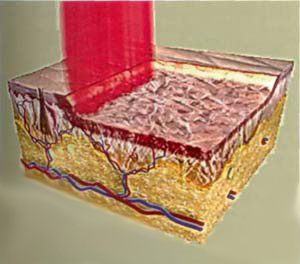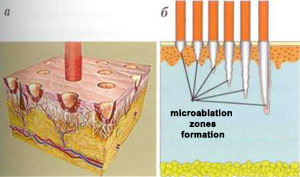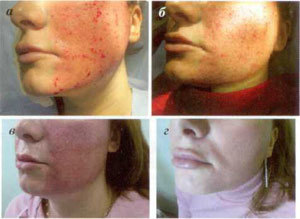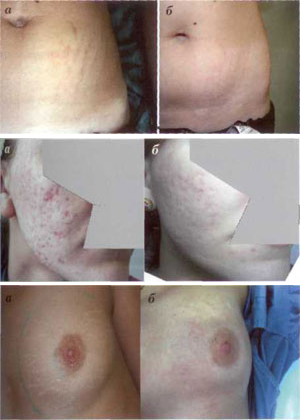Today, in the arsenal of modern dermatocosmetology, there is a fairly wide range of methods for correcting various aesthetic skin defects - chemical peeling, mechanical dermabrasion, laser resurfacing, microdermabrasion, contour plastic, and others. However, new directions and technologies in the beauty industry are constantly being developed and improved.
This trend is typical for hardware methods, especially laser medicine. There is an impressive period of use of lasers, first in dermatology and then in cosmetology. Evenlaser therapy methods - selective photothermolysis - have been around for more than 25 years since the emergence of one of the newest. Pioneers of this direction, American RR Anderson and JA Parrish, predetermined the fate of fractional lasers in medicine, making them indispensable for this type of aesthetic treatment. skin imperfections such as capillary hemangiomas. Port wine stains, hypertrichosis, tattoos, rosacea, pigmentation disorders, photoaging, wrinkles etc.
Modern skin remodeling techniques
We live in a time where more people than ever before are living with aging. Considering that many of them continue to live actively, one of the most important problems in aesthetic medicine is the fight against aging skin.
Plastic surgery can rejuvenate the shape of the face by removing excess skin. However, at the same time, the skin still remains altered with time (age-related aging) or by external factors (photoaging). What most patients want is also important. Look younger without surgery.
In this case, what method should be used to affect the skin and what should be in it for its true rejuvenation?
All methods that can be used to improve the appearance of the skin are combined with one principle - they use a traumatic effect on the skin, triggering fibrosis, which causes the skin to tighten and tighten.
Currently, dermatocosmetology uses three main types of remodeling effects on the skin:
- chemical stimulation - chemical peeling with acids (trichloroacetic, glycolic etc. );
- mechanical stimulation - mechanical dermabrasion, microdermabrasion, mesotherapy, fillers, needle undercuts;
- thermal stimulation - laser ablation, thermolifting using lasers and broadband light sources, radiofrequency lifting, fractional methods.
Chemical warning
Historically, acid exfoliation (peeling) was the first method of skin rejuvenation. The principle of peeling is that the epidermis is partially (as in superficial peeling) or almost completely (as in medium and deep peeling) destruction, damage. fibroblasts and dermis structures. This damage triggers an inflammatory reaction in the skin that leads to additional collagen production (the stronger the breakdown volume is).
However, peeling must sacrifice the epidermis to achieve the desired result. Experiments with burns have misled many by "proving" that the epidermis is a self-regenerating organ that quickly heals the damaged area. domain. In this regard, up to a time the peels became more and more aggressive against the epidermis (for example, deep phenolic peeling), until the problems that eventually accumulated became experts realizing the cruelty of this. a method that ultimately leads to thinning of the skin.
Advocates of deep stripping ignored the issues that arose. Their essence was that the epidermis was thinned due to the destruction of the papillae of the dermis and the weakening of nutrition, and the number of cells in the prickly layer was significantly reduced in comparison. with what happened before they were robbed. A decrease in the barrier function of the stratum corneum leads to a decrease in skin hydration. (Therefore, almost all patients experience severe dry skin after prolonged deep peeling) At the same time, the light peels (using trichloroacetic and fruit acids) failed to meet the hopes of effectively tightening the skin.
Mechanical stimulation
From methods of mechanical stimulation of evolutionary changes in the skin, dermabrasion with the use of rotary devices (speed v; rotating the incisors up to 100, 000 rpm) deserves special attention. Currently modern Schumann-Schreus devices are used (Germany)
The method can only be used in surgical hospitals, as the method requires anesthesia assistance, postoperative treatment of the wound surface, a special toilet for the eyes and mouth, as well as devices that require surgical intervention. feeding patients (due to the apparent postoperative edema that occurs 2-3 days after the procedure making it difficult to open the eyes and mouth).
The method is very effective, but unfortunately there is a high risk of complications in mechanical dermabrasion such as:
- permanent postoperative hyperemia;
- The appearance of depigmentation areas due to the destruction of melanocytes when entering through the cutter basement membrane;
- wound surface infection;
- scar (if the cutter is too deep into the skin)
All of the above has determined the limited application of this method in clinical practice.
Thermal stimulation
Ablative remodeling
Since the late 1980s, a laser has been used to rejuvenate the skin by layer-by-layer tissue removal (ablation) [4]. Careful, low-traumatic removal of the surface layer of the skin using carbon dioxide laser stimulates the synthesis of its own collagen in it, Its amount increases several times after the procedure. Then it is gradually rearranged.
The most effective was the use of a CO2 laser, which results from the skin tightening effect externally when exposed to a deep thermal effect on all layers of the dermis. This method cannot be opposed to "laser dermabrasion" or "laser resurfacing" and any other skin rejuvenation method existing at that time in terms of efficiency (Figure 1).

Figure. 1. Traditional laser skin resurfacing scheme (laser dermabrasion)
However, the CO2 laser also causes a multitude of complications. In addition, further studies have shown that such a profound effect on the dermis stimulates the formation of fibrous tissue to a greater extent as it contributes to the synthesis of a new, normal synthesis. oriented collagen [5]. Advanced fibrosis can cause the skin to appear unnaturally pale. Collagen synthesized after treatment is absorbed after a few years, like any collagen formed in the scar area. As a result of thinning epidermis caused by atrophy of the papillary layer of the dermis, fine wrinkles begin to form on the skin. Due to the weakening of the barrier function of the stratum corneum, the hydration level of the skin decreases and appears atrophic.
Erbium-aluminum-yttrium garnet-erbium lasers appeared a little later. Such advantages of an erbium laser as a shallower thermal penetration depth (erbium lasers penetrate to a depth of 30 microns, CO2 lasers - up to 150 microns) and (consequently) a lower risk of burns and tissue carbonization, as well as relative cheapness (compared to carbon dioxide lasers). ) caught the attention of many experts around the world.
However, as experience of working with these two types of setup has accumulated, the view that CO2 lasers are more efficient has developed among experts [6]. Despite the negative effects of the carbon dioxide laser dermabrasion described above, this method is indispensable for correcting acne scars. In addition, surgery can be considered as an alternative to skin tightening - in all remodeling methods, exposure to only one CO2 laser is actually collagen contraction with a pronounced clinical lifting effect.
The problem with all of the methods described above is that they often "sacrifice", meaning they cause significant damage to the epidermis. To rejuvenate your skin and look really young, you need a natural and perfect epidermis. papilla of the dermis, good hydration, normal skin tone and elasticity. The epidermis is a very complex, highly specialized organ up to 200 microns thick, which is our only defense against the effects of adverse environmental factors. Therefore, whatever we do to rejuvenate the skin, we must make sure that its underlying normal architecture is never damaged.
This concept contributed to the emergence of non-ablative skin remodeling technology.
Non-ablative remodeling
The most common devices for non-ablative skin remodeling are neodymium (Nd-YAG) and diode lasers and broadband light sources (IPL). The principle of their action - selective photothermolysis - consists in heating and destroying structures, contains a sufficient amount of melanin or oxyhemoglobin. In the skin, these are deposits of melanocytes (lentigo, melasma) and microvessels (telangiectasia), respectively. The emitted wavelengths used in non-ablative lasers correspond to the maxima of the absorption spectra of oxyhemoglobin or melanin. The treatment procedure with non-ablative lasers and IPL is quite safe, the rehabilitation time is minimal, but such treatment only removes pigment and vascular cosmetic defects. In this case, there is a certain thickening of the skin, but the effect obtained is short-lived.
Fractional Skin Remodeling Techniques
Continuous research into highly effective and at the same time safe methods of skin rejuvenation has led to the emergence of a revolutionary technology - the fractional transmission of laser radiation. The proposed method of skin rejuvenation is specifically designed to overcome. some of the difficulties above. Unlike "traditional" ablative and non-ablative laser methods designed to provide uniform thermal damage to the skin at a given depth, fractional methods achieve selective microscopic thermal damage in the form of multiple modified columns and leave unaffected areas around these micro wounds. Currently, the industry produces two types of fractional lasers: non-ablative and ablative.
The first uses an erbium-doped optical fiber that produces radiation at a wavelength of 1550 nm. The fractional laser creates thousands and tens of thousands of microdamages in the skin - columns with a diameter of 70-150 - microthermal treatment zones (MLZ). Up to 1359 mcm mk depth
As a result, approximately 15-35 skins are photocoagulated in the treated area. Chromophore for laser is water. Coagulation occurs mainly in the lower layers of the epidermis and dermis. The stratum corneum remains intact as it contains. relatively little water and this significantly reduces the risk of infection. Epidermal recovery is rapid due to the low lesion volume and short migration distance of keratinocytes. It accompanies the recovery period5-7. moderate edema and hyperemia occurring on the day, followed by desquamation. The patient practically does not lose his social activity.
This technology - fractional photothermolysis (FF) - is a highly effective method of non-ablative fractional skin remodeling. A course therapy is prescribed to achieve the desired effect. Depending on the clinical situation, it is recommended to perform 3 to 6 procedures at an interval of 4-6 weeks. As with any other non-ablative skin reshaping method, the final result can be seen only 4-8 months after the procedure (cumulative effect).

In cases where a more aggressive effect on the skin is required - the fractional ablation method (FA or fractional deep dermal ablation -FDDA) is used to correct scars, remove deep wrinkles and excess skin.
Fractional ablation method combines the advantages of CO2 laser and the fractional principle of laser radiation distribution. Unlike conventional CO2 lasers that lift the entire skin surface layer by layer, FA units create a large number of microablatives (MAL) up to 300 µm in diameter at an evaporation depth of 350 to 1800 µm (Fig. 2).
Thus, the laser radiation that penetrates the deep layers of the skin during this process destroys the upper layer of the epidermis. In terms of efficiency, ablative fractional laser rejuvenation is comparable to plastic surgery, this is the depth of laser beam reappearance.
Figure. 2. Working principle of ablative fractional laser: formation of microablative regions - MAZ (a); Dependence of MAZ formation depth on laser radiation power (b)
As in the case ofFF, 15% to 35% of the skin of the treated area is actually exposed (in some cases up to 70%). Recovery after the FA procedure is faster than stratified ablation. This is due to the fact that the important part of the repidermis and stratum corneum remains intact. Immediately after the procedure, skin bleeding occurs for a while, but stops after a short time (Fig. 3 a, b).
Figure. 3. Step-by-step skin restoration after fractional ablation procedure: imaging immediately after treatment (a); every other day (b); (C) after 5 days; 14 days (d) after a procedure

Numerous microhemorrhages occur in the dermis, causing a complex series of changes that lead to the production of new collagen. After the bleeding has stopped, the serous fluid remaining on the skin surface should be removed. It is released 48 hours after the procedure until complete epithelization of the microablative regions. During this time, the patient uses special wound healing agents. Peeling and swelling increase, which usually starts after 3-4 days (Figure 3c). By the 7th day, this phenomenon gradually subsides and the only noticeable side effect remains a rash (Figure 3d). The erythema time depends on the laser exposure parameters. and features of skin vascularization. According to the author's observations, erythema does not last more than 3 months.
The patient's loss of social activity lasts 5 to 10 days after the FA procedure.
The skin should be carefully cared for to prevent scarring and the manifestation of post-inflammatory pigmentation. Decorative cosmetics can be used between 4-5 days. A prerequisite for a good result is the use of sunscreen with a high degree of protection (SPF at least 50) for at least 3 months after cosmetic treatment. The risk of postinflammatory pigmentation occurs in 20% of patients and is generally higher in skin patients. IV-V phototypes. This type of hyperpigmentation is temporary in nature and can last from 1 week to 3 months, depending on the depth of treatment and the area of the treated area. External agents based on hydroquinone (4%) and tretinoin (0. 1%) are prescribed 1-2 weeks before the procedure and for prevention during the procedure, 2 weeks after that. The main effects on facial skin after the FA procedure are: marked tightening and reduction of excessive skin, flattening of the surface, congested skin, as well as skin affected by acne scars, decrease in dyschromia, porosity.
This method has also been tested by the author and colleagues to remove stretch marks from the skin. As demonstrated by clinical studies, the method has shown high efficiency in removing almost all types of stretch marks, both acquired in adolescence. period and postpartum. It was noted that the healing processes in the skin of the body are different from the skin of the face.
Skin remodeling mechanism when using fractional lasers
Let's consider skin remodeling mechanisms when using fractional lasers.
After exposure to the laser, aseptic inflammation develops in the area of micro wounds. The more aggressive the laser exposure, the more pronounced the inflammatory response is that it actually stimulates post-traumatic relaxation. growth factors and infiltration of damaged tissues by fibroblasts. The incoming reaction is automatically accompanied by an explosion of cellular activity, which inevitably causes the fibroblasts to start producing more collagen and elastin. The skin remodeling process includes three classical regeneration steps:
- stage I - change (tissue inflammation). Starts immediately after damage;
- stage II - proliferation (tissue formation). It starts 3-5 days after injury and lasts about 8 weeks;
- phase III - tissue remodeling. Lasts from 8 weeks to 12 months.
It should be noted that all three phases of skin remodeling are observed both after fractional photothermolysis and after fractional ablation. But in the first case, the damaging effect of the laser is moderately aggressive and as a result a series of inflammatory changes are never too wild.
After exposure to the fractional ablation laser, a completely different picture is observed. The trauma caused by this laser breaks the blood vessels and blood cells along with the serum are released into the surrounding tissue. Full-fledged skin regeneration mechanism - phase change begins - aseptic inflammation develops. Platelets released from damaged vessels play an important role in activating blood clotting and releasing chemotoxic factors. Other platelets, leukocytes and fibroblasts are attracted in turn. Leukocytes, especially neutrophils, participate in the removal of necrotic tissue fragments that have been partially destroyed by the phagocyte, and the cleansing of partially destroyed tissue. It appears on the surface of the skin in the form of microscopic rash consisting of epidermal and dermal tissue substrates and melanin - microepidermal necrotic debris (MENO).
The propagation phase starts in about 5 days. During this period, monocytes replace neutrophils. Monocytes, keratinocytes, and fibroblasts continue to affect growth factors and also suffer adverse effects. Keratinocytes stimulate the growth of the epidermis and the release of growth factors necessary to stimulate collagen production by fibroblasts. At this stage, new blood vessels are formed and the extracellular matrix is densely formed.
The final, reconstructive, healing phase after exposure to the fractional laser takes several months.
On day 5 after injury, the fibronectin matrix "sits" along the axis where the fibroblasts are lined and collagen will be built. An important role in the formation of this matrix is played by transforming growth factor β (TGF-β is a potent chemotoxic agent for fibroblasts) and other growth factors. The main form of collagen in the early stage of wound healing is type III collagen (this type of collagen is located in the upper layer of the dermis, just below the basal layer of the epidermis). The longer the change phase, the more type III collagen is produced, but in any case its amount will maximize between 5 and 7 days after damage. Type III collagen is gradually replaced by collagen in about a year. Type I, which strengthens the strength of the skin, blood circulation gradually returns to normal, the skin becomes smoother and takes on a natural color.
Comparative analysis of laser skin remodeling methods
Summarizing the above, here is a diagram showing the relationship between the effectiveness and safety of laser skin remodeling techniques.
Advantages of fractional part rejuvenation methods. Advantages of fractional methods used in clinical practice include:
- controlled minimal skin damage. Histological studies performed after the procedure show an increase in the number of papillae in the dermis, which characterizes the changes in the skin as productive regeneration;
- effective rejuvenation: skin thickens, significantly (more than 400% (! )) increases collagen and elastin production;
- short recovery time: 3 days after FF and 7-14 days after PA;
- minimum risk of hyperpigmentation;
- possibility of performing the procedure on patients with thin skin;
- the ability to have a healing effect anywhere on the body;
- Possibility of using mild type of anesthesia: only local application anesthesia is used in fractional photothermolysis, a combination of conduction and infiltration anesthesia is required for fractional ablation;
- Elimination of telangiectasias (restoration is impossible due to rupture of blood vessels in many places).
Main indications for fractional therapies

Indications for fractional photothermolysis:
- increase in skin density in the early stages of aging. The FF procedure is relatively easy and can be applied without fear. The therapeutic effect can be applied on the neck, décolleté, arms, abdomen, thighs, mammary glands;
- skin photographing;
- hyperpigmentation, melasma;
- hypertrophic scars;
- cracks.
Fractional Ablation Indications:
- wrinkles of varying severity - more pronounced than fine lines (grooved);
- age-related loss of skin elasticity and firmness;
- excess skin on eyelids, neck and face (as an alternative to plastic surgery);
- uneven skin texture;
- Significant photoaging on the skin;
- acne scars;
- Cicatricial deformity of the skin after injuries, surgeries;
- hyperpigmentation: melasma, lentiginosis, mottled pigmentation etc.
- vascular dyschromia;
- skin cracks;
- actinic keratosis.
To conclude, a few words about the prospects for the use of laser technologies in aesthetic medicine. We must pay their respects to manufacturers as they are starting to pay more attention to the safety of medical procedures using lasers. Technology has constantly improved. However, the safety of the method was often sacrificed to increase its effectiveness. Or vice versa. A compromise was found in the new principle of delivering laser radiation to tissue. It should be noted that the types of lasers remained the same: erbium, carbon dioxide, neodymium. This means:
- first, laser skin remodeling is considered the most effective method today;
- Secondly, the scope of aesthetic and dermatological problems solved by these methods is extremely wide - from skin rejuvenation to treatment of congenital and acquired skin pathologies; Third,
- , with the advent of fractional technologies, the safety and efficacy of treatment has become predictable.














































































